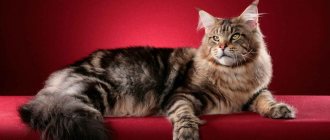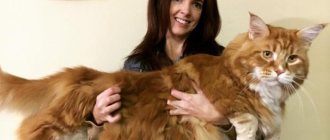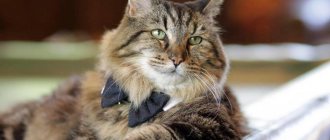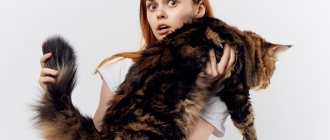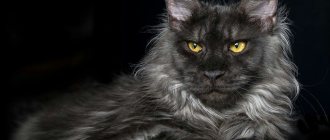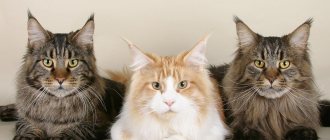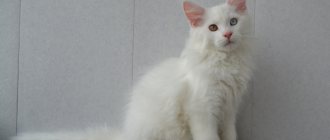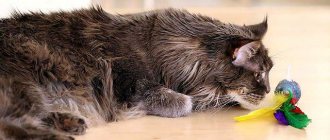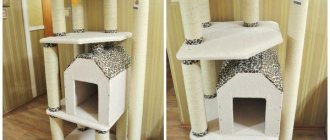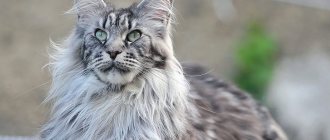There are many international felinological associations, but they have different standards for conducting shows and even criteria for evaluating cats.
The same Maine Coon is capable of leaving the ring with the rank of champion or not even receiving a diploma - it all depends on the prevailing competitive circumstances and the conditions of the competition. Not all pet lovers are familiar with the rules of exhibitions. Let's find out how authoritative felinological organizations determine the breed standard.
WCF system (Europe)
At open exhibitions, judges describe the animal, evaluate its character and appearance in accordance with internal rules also adopted among other European organizations. Owners of all breeds will be present during the inspection of the exhibitor. An exhibitor can receive a maximum of 1 rating per day.
Standard according to WCF:
- Body. Rectangular in format, large or very large, well-developed muscles, wide chest.
- Limbs. Medium length, strong and muscular. There are tufts of fur on the paw pads, between the toes.
- Tail. Long, reaches to the shoulder. Wide at the base, tapering towards the end. Covered with long hair.
- Scull. Square, large, with a clearly defined transition from the muzzle to the forehead. The chin, nose and upper jaw are level.
- Eyes. Large, oval, set wide and slightly oblique. The color matches the coat color.
- Ears. Large, wide at the base and tapering towards the tip. The distance between them is no more than the width of the ear at the base. The posture is high and almost vertical. The presence of tassels at the tips is a desirable, but not mandatory, component of the exterior.
- Coat. Waterproof, fits tightly to the body, covers half the tail, back of the body and limbs. The undercoat, unlike the topcoat, is soft and dense. There is only undercoat on the belly and “pants”. A lush mane is a desirable, but optional criterion.
- Color. Any options are allowed, except for chocolate, lilac, caramel and cinnamon color in any combination.
The disadvantage that does not allow one to qualify for the CAC title is the coat of the same length throughout the body.
Photos from the exhibition
Eye color standards
Each breed has a personal accepted standard for eye color. These are quite strict rules that should not be broken.
So, which breeds have strict restrictions on eye color:
- Abyssinian cat. This breed can only have green or yellow eyes.
- Burmese cat. This beauty's eyes can only be light gold.
- Burmilla. Green of any intensity.
- Balinese. Blue or blue eyes.
- Bombay cat. Only deep copper eye color.
- Burmese cat. Exceptionally bright blue eye color.
- Havana brown. Green or yellowish-green.
- Egyptian Mau. The eyes are light green (gooseberry color).
- Korat. Amber or amber-green eyes.
- Kao-mani. Yellow or blue eyes.
- Lykoy. Yellow or amber eyes.
- Nibelung. Only gooseberry eye color.
- Oriental cat. Green eye color is preferred.
- Ojos azules. Only blue eyes.
- Pixie bob. The eyes are gooseberry-colored, brown or yellow.
- Russian blue cat. Exceptionally green eyes, from light to rich emerald.
- Ragdoll. Only blue eyes.
- Siamese cat. Blue or blue eyes.
- Tonkinese cat. Aquamarine, blue or yellow eye color.
- Thai cat. Only deep blue eye color.
- Turkish van. Only gold or blue.
- Chausie. Yellow, copper, hazel or green eye color.
- Chartreuse (Carthusian cat). Copper, orange or amber eyes only.
The standard of some cat breeds allows them to have only a certain eye color (pictured are Havana Brown cats)
In some breeds, eye color may depend on coat color:
- British cats of the black solid, blue solid, cinnamon, fawn, and lilac colors cannot be green-eyed or blue-eyed.
- British Chinchillas and British Goldens can only have green eyes.
- White Turkish Angoras can only be blue-eyed, green-eyed, or yellow-eyed.
- In Oriental cats, yellow and blue are allowed in solid (solid) colors and blue in color-point colors.
Some interesting facts about eye color in cats:
- A Sokoke cat can change eye color depending on its mood.
- Very often, blue-eyed cats (especially white ones) are deaf.
- All cat lovers know that the blue-eyed gene in purring cats is recessive. However, in cats of the Ojos Azules breed, this gene somehow mutated into a dominant one. They can also be green-eyed or yellow-eyed. Also, deafness is not associated with the Ojos blue-eyed gene and they cannot be bred with other blue-eyed cats.
- All color-point cats can only be blue-eyed or blue-eyed. Their eyes absorb all colors of the rainbow spectrum except blue. They reflect it and therefore appear blue-eyed. But the brightness of blue depends on the amount of pigment: the more pigment there is, the paler the color of the cat’s eyes. In very rare cases, Color Points may have yellow eyes.
- If a cat has no pigment in her eyes, she will be red-eyed. This only occurs with albinism.
- Albinos can also have blue eyes (this is called partial albinism).
- As surprising as it may sound, outbred cats usually have much richer eye color than many purebred cats.
Abyssinian cats most often have green eyes
Cat's character, interaction with other animals, owners and children
The Maine Coon is an active and quite energetic animal. Such a cat needs constant attention - you need to play with it and let it run around the apartment. The animal has the habits of a born hunter, and it will happily play with a mechanical mouse, catch soap bubbles or a ball.
You don't have to be afraid to get this cat if you have children in the house. Maine Coons live in peace with children and never offend their little owners. However, these cats do not always get along easily with other pets. You should not get such a pet if there is a rodent living in the apartment - a chinchilla, guinea pig, hamster. A Maine Coon may attack an animal, considering it potential prey.
Otherwise, these animals are not aggressive, have a friendly character, and adapt well to any conditions. Cats have developed intelligence, which allows them to understand their owner literally at a glance. The Maine Coon can be taught some tricks if the lesson is done in a playful way.
Maine Coons have a gentle voice that many owners describe as a "musical purr." It is believed that it is impossible to find two kittens with the same timbre - the voice of each has individual characteristics.
Breeding Features
Breeding Maine Coon mestizos is strictly prohibited; the seller must inform the buyer that the animal is a half-breed. However, buyers themselves should also not let down their guard and not buy kittens at discounts.
If you cross a male Maine Coon with a female of smaller cat breeds, the mother will most likely die during childbirth due to the kittens being too large.
In terms of friendliness and sociability, mestizos are categorical in nature: a kitten can be either too friendly and even somewhat annoying, or aggressive. Unscrupulous breeders, as well as inexperienced fanciers, for example, seeing that the kitten looks like a Bengal and not a Maine Coon, and are dissatisfied with the appearance, can simply throw the animal out into the street, dooming it to hunger and wandering. Therefore, they often try to sell kittens as early as possible, while it is difficult to distinguish them from purebred ones.
It is often better to buy a purebred Siberian cat than a mixed breed. Purebred felines are much better in health and character than a mixture.
TICA (America)
The second largest felinological organization in the world, founded in 1079, its main office is in the USA. Exhibition activities comply with American rules and require open judging and the judge not having any information about the animal and its titles.
TICA unites not clubs, but Maine Coon breeders and owners, and the judges of this organization must regularly confirm their qualifications.
TICA standard:
- Head. Wide, in the shape of a modified wedge, the forehead is rounded, the cheekbones are prominent.
- Ears. Large, with a wide base, medium pointed, set high relative to the head, the auricle is slightly inclined outward.
- Eyes . Large, set wide. Their color has nothing to do with the color of their coat.
- Color. Any color is acceptable, as well as a white outline around the chin, eyes and lips.
- Coat. Serves as protection from weather conditions; there is a small undercoat, the quality of which should be different from the outer coat.
A Maine Coon can be fined for:
- Eyes wide open.
- Small size.
- Rounded head shape.
- Short tail.
- Long limbs.
- The coat is the same length.
- Specks, spots.
- Sparse undercoat.
- Almond-shaped eyes.
- Ears located close to each other.
- Short tail.
Reasons for disqualification:
- Aggressive behavior, attempts to bite or scratch the judge.
- Cryptorchidism.
- Lack of tail, its creases.
- Strabismus, blindness.
- Extra fingers or xiphoid process.
- Size inappropriate for breed.
It is strictly prohibited to use representatives of other breeds in Maine Coon breeding.
Historical reference
For the first time they started talking loudly about representatives of the Maine Coon breed after the international exhibition of 1861 . When everyone was fascinated by the beautiful, phlegmatic giant from North America. It is the state of Maine in the northeastern United States that is considered the birthplace of these fluffy beauties, also called “coon cat” and also having tufts on the tips of their ears, similar to lynx cats.
Hence the origin of some legends telling about the appearance of these cats as a result of crossing, in one case - between cats and raccoons, in another - between cats and lynx.
This is interesting! There are also more realistic assumptions that speak in favor of the appearance of these animals in North America as a result of travel on ships from Europe: with the Vikings, with the property of the Queen of France, or with a certain Captain Kuhn.
The most plausible explanation seems to be the origin of this breed as indigenous to the specified territory as a result of many years of work by nature itself, endowing the feline representatives with certain features that allow them to better withstand difficult weather conditions.
And the climate of this state is not particularly mild: humid summers and snowy, frosty winters - these factors influenced the transformation of Maine Coons and gave them such properties as thick long hair, a powerful body, high paws, and long mustaches. By the nature of the Maine Coon - calm, concentrated, even phlegmatic - one can judge his self-confidence.
The history of human friendship with this breed goes back more than 150 years: at first, Maine Coons were indispensable assistants to farmers in the fight against rodents - their textured beauty remained unnoticed by their owners and was underestimated, until the already mentioned 1861.
In the middle of the last century, Maine Coons were also appreciated by residents of Europe, and since then this breed has confidently been among the top ten in popularity in the world, and in some countries of the world - in the top five and even in the top three. Exhibitions of this breed are held by many felinological organizations; best known for their activities:
- WCF (Word Cat Federation);
- TICA (The International Cat Association inc.);
- FIFE;
- CFA et al.
Return to content
Nutrition
When purchasing a small Maine Coon, it is better to feed him his usual food for a while. Then you can introduce the kitten to other foods.
A complete diet for a small Maine Coon should contain up to 40% protein, 15-30% fat, 2.5% fiber, and the rest should be carbohydrates.
When feeding kittens, it is important to follow a diet. The main diet is raw lean meat. These are beef, chicken, rabbit, and offal. To strengthen joints, you need chicken scallops, beef tendons, and pig ears. Meat should be frozen for at least three days.
The source of minerals will be raw chicken necks, heads, backs, paws, and tails. They must be ground or given whole. Raw yolk is very useful for kittens.
When purchasing a small Maine Coon, it is better to feed him his usual food for a while
Fish should be given with caution and infrequently. Kittens drink milk for up to two months, and then their body loses the ability to digest lactose. It is replaced with fermented milk products, cottage cheese, and hard cheese.
Sometimes kittens happily eat raw grated vegetables and fruits and herbs. Adding a small amount of olive oil will help. There must be clean water available at all times.
It is not recommended to feed kittens food from the human table: it contains too many different additives that are harmful to the animal’s digestion.
Natural nutrition table for Maine Coon kittens by month
The nutritional norms and diet for Maine Coon kittens are presented in the table:
| Age in months | Daily value in grams | Number of feedings per day | Diet |
| Up to a month | Around the clock | Mother cat's milk | |
| 1,5-2 | 150-190 | 6 | Milk, liquid porridge, pureed meat |
| 2-3 | 180-240 | 4 | Raw lean meat, liver, some sea fish, vegetables, fruits, egg yolk, kefir, yogurt, a little olive oil. |
| 3-6 | 180-220 | 4 | Offal, chicken feet, heads, backs are added |
| 6-9 | 200-250 | 3 | Same diet |
| 10-12 | 180-220 | 2 | Same diet |
Feeding kittens with prepared food
High-quality industrial cat food contains all the necessary nutrients. Some manufacturers produce special food for Maine Coons: Bosch Sanabel Kitten, Royal Canin, Hills.
Be sure to read:
What to feed a Maine Coon kitten: recommendations, diet from a month to a year, what not to give
The amount of dry food is calculated individually and depends on the size of the kitten. First, the granules should be diluted with store-bought milk. Adults can be given canned food.
Industrial feeds are stored for a long time and are convenient to use. The packages usually indicate the serving size and other recommendations.
When do kittens' eyes change color?
This depends largely on the heredity and breed of the kitten. In outbred cats, eyes, as a rule, begin to change at the age of 1–1.5 months. In purebreds, this process can begin between 1 and 12 months of age. The final eye color is established by the age of two.
Blue-eyed cats have very little melanin in the iris. Certain genes are also responsible for its quantity. However, this trait is recessive, so such cats are very rare.
The more pigment in the eyes, the darker the color of the cat's eyes.
Absolutely all kittens' eye color becomes brighter by the age of one month. This is due to the fact that after the eyes open at 10–12 days of age, they are covered with a film. Because of this, the shade appears grayish. By 3–4 weeks, the film disappears, making the color of the eyes brighter.
This process has given rise to many myths on the Internet:
- All kittens have bright blue eyes. In fact, they can be bright blue, light and dark blue, gray-blue in various shades.
- Eye color directly depends on color. This statement is true only for purebred cats, in which a certain trait has been fixed through long selection, and for color-point cats. But in fact, the eye color can be absolutely any with absolutely any color.
- Eye color depends on diet. This has not been confirmed in any way by science or felinologists. It is only known that the color of a cat’s coat can change with a certain diet (for example, color-point colors darken from frequent feeding with fish).
Color-point cats have fur that is darkened by fish.
FIFe (Europe)
The FIFe system, founded in the first half of the 20th century, is today the main one for many clubs. Representatives of different breeds can take part in exhibitions, and the regulations were developed exclusively for internal users. The current Maine Coon breed standard has several differences from other systems:
- Big size.
- The space between the ears increases as the cat ages.
- Clear eye color is desirable, but not required.
- Males have a strong neck with well-developed muscles.
- The color allows any amount of white fur.
- The type of cat is more important than the color of the coat.
The disadvantages of the breed specified in FIFe coincide with those described in the standards of other systems.
Main reasons for color change
Eye color depends on the amount of pigment in the cells of the cornea, the formation of which begins in the embryonic period.
The cat's gestation period ranges from 55 to 63 days. In this short period of time, inside the mother, two united cells must develop into a relatively large, smoothly working organism.
The mother's resources are limited, so the melanin she synthesizes is primarily sent to the skin and fur cells of the fetus. This allows you to quickly form reliable covers for effective thermoregulation and protect the kitten from an aggressive external environment. In this case, the cells of the iris are deficient in melanin, which is why they remain colorless during birth and several weeks later. As the kitten grows, its eyes gradually open, vision becomes clearer, and the eyes acquire a color dictated by breed and heredity.
Anatomically, the cat's cornea consists of two layers: stroma (upper) and epithelium (lower).
The degree of saturation of the stroma with melanin determines the shade of the kitten’s eyes. If there is little of this substance in the cells of the iris, the eyes will be blue or blue. If a little more - green. With a high melanin content, the eyes turn coppery brown.
Maine Coon weight and height by month
In order to clearly determine whether your pet is growing normally in size, the table shows the weight of kittens by month. As you can see, a Maine Coon at 1 month is already larger than a regular cat.
Up to a year, development occurs very quickly and a Maine Coon kitten weighs more than a kilogram at 2 months. Maine Coon kittens at 3 months are larger in size than some adult cats of other breeds. A Maine Coon at 4 months weighs up to 3.5 kg, and this is not the limit for them.
A Maine Coon at 5 months already exceeds 4 kg, which is quite rapid growth. The weight of a Maine Coon at 6 months is 5.3 kg for males. At 7 months they have the weight of an adult cat of most breeds. At 8 months the animal is heavier than 5.5 kg.
The weight of a Maine Coon at 9 months reaches 7 kg, and at just 10 months the cat already looks like a real giant. And at 1 year the pet’s weight reaches 8.5-9.5 kg, this is the time of the most powerful weight jump.
The size of the animal depends on many factors, do not be upset because your pet does not meet the standards; however, be vigilant and do not be negligent about the health of your pet.
Maine Coon weight chart
| Age | Average weight of a female (in g) | Average male weight (in g) |
| 1 Week | 190 | 230 |
| 2 weeks | 340 | 380 |
| 1 month | 600 | 700 |
| 2 months | 1250 | 1350 |
| 3 months | 1850 | 2200 |
| 4 months | 3000 | 3400 |
| 5 months | 3500 | 4500 |
| 6 months | 3800 | 5000 |
| 7 months | 4300 | 5500 |
| 8 months | 4800 | 6000 |
| 9 months | 5000 | 6300 |
| 10 months | 5300 | 6900 |
| 11 months | 5700 | 7400 |
| 1 year | 6000 | 8000 |
| 2 years | 6800 | 10000 |
| 2 and a half years | 7300 | 12500 |
| 3 years | 8000 | 14000 |
Color
The color has an incredible variety of shades, they are classified as follows:
- tabby - stripes of different colors on a background of different shades;
- solid – monochromatic color, available in white, cream, black, blue and red shades;
- smoky – smoky, comes in various shades: black, blue, chinchilla, silver;
- calico - distinguished by rare large spots on a white background;
- tortoiseshell - characterized by random multi-colored spots throughout the body.
There is an opinion that the character of these cats depends on their color, for example, black cats are flexible, tortoiseshell cats are restless, tabby cats are independent. Therefore, you can choose a kitten that is most suitable in color and characteristics.
CFA
According to the general description, Maine Coons are strong cats with great endurance and are adapted to life in difficult climatic conditions. These are well-balanced and harmoniously built animals, without signs of excess. The main feature of the breed is its smooth and shiny coat. When assessing a particular specimen, type, not size, is of paramount importance.
Description of the standard:
- Head. It has medium length and width, a square-shaped muzzle. A wider head does not cause fines or disqualification of the animal, if we are talking about stud cats.
- Ears. Large, with pointed tips and tassels on them. Set wide and high, the distance between them approximately coincides with the width of the ear at the base.
- Eyes. Large, slightly convex, set wide and slightly oblique. They can be green, gold, golden-green or copper. Blue eyes are allowed only in representatives of the breed with a white coat or bicolors.
- Body. Medium or large, rectangular, well-developed muscles. The neck is of medium length, the chest is wide.
- Limbs. Strong, medium length, proportional to the body. The pads are round and there are tufts of fur between the toes. The front paws have 5 toes, the hind paws have 4.
- Tail. Long, tapering towards the end, covered with long hair.
- Coat. Fluffy, long, silky. Shorter on the shoulders than on the belly and hind legs.
- Coat color. White, black, blue, red, cream colors, various variations of tabby and tipping colors are allowed.
Reasons for disqualification:
- Light frame.
- Wedge-shaped or narrow muzzle.
- Malocclusion.
- Strabismus.
- Noticeable use of cats of other bloods when breeding an animal.
Chocolate, lilac, cinnamon or Siamese coats are not acceptable.
Why do cat eyes change color?
Most members of the cat family have irises ranging from greenish-yellow to golden. In some animals it has a different shade. For example, Siamese cats have blue eyes even in adulthood.
Those with white spots on their coats are also sometimes blue-eyed. The snow-white markings are explained by a special gene that also affects the shade of the eyes. Individuals with a snow-white coat have blue eyes.
Kitten with heterochromia
Sometimes the “white spot gene” leads to a deficiency of pigment in only one organ of vision, while the other retains normal pigmentation. This is how animals with different colored eyes are born. This feature is called heterochromia. It also happens in pure white individuals. Thus, the popularity of Angora cats is also due to the fact that they are often born with heterochromia.
What influences development
The development of a purebred pet is influenced by the following factors:
- Floor; girls are usually born smaller in size than male maikunas; Adult cats are also different; they weigh less.
- Number of babies in the litter; most often 4-5 individuals are born. If a cat has 6-7 kittens, each weighs about 100-120 g;
- Parameters of the mother and her nutrition during pregnancy. Food rich in proteins, fats, vitamins and beneficial microelements will support the cat’s health and provide the baby’s body with the necessary substances;
- Conditions of detention; a clean, healthy, vaccinated and treated animal for ticks, fleas and worms is stronger than its unkempt counterparts;
- Selection work of the breeder; affects the formation of the skeleton and skull of the pet.
- Stressful condition in a cat. The composition of mother's milk in an unfavorable situation deteriorates, this affects the growth of babies.
Why do newborn kittens have blue eyes and how eye color changes
To understand exactly how the change in eye color in kittens works, you need to start with the very development of the kitten in the womb. Already at the initial stages, 34 pigment centers are localized in the embryo, from which the pigment, during the growth and development of the kitten, moves mostly to the hair follicles and accumulates there. There is negligible amount of it in the iris.
The most interesting thing is that the pigment continues to accumulate after birth, which is why the color of the kittens’ eyes changes.
But why do all newborns have blue, gray-blue or blue eyes? It's all about the amount of pigment (melanin) - it is known that the less pigment, the lighter and cooler the eye shade. At the time of birth there is little of it in the iris. This is the reason why all babies have cool blue or light blue eyes.
There is no pigment in the eyes of newborn kittens, so they have blue eyes.
Actually, what final eye color a kitten will have is determined by a set of genes inherited from the parents to the baby. It is responsible for the amount and presence of pigment in the eyes and the speed of its movement there. This is what determines when the eye color changes and what it will be like.
The cat's iris is divided into two layers: the upper one is the stroma and the lower one is the epithelium. It is the amount of melanin in the stroma that is responsible for eye color. If there is a lot of it, then the color will be brown or copper, if less - green, if very little - blue or cyan.
With a probability of at least 50% you can predict what eye color a kitten will have if you look at its parents
Comparative table of the rating scale in points
| Category | CFA | TICA | FIFe | WCF |
| Head | 30 | 40 | 40 | 30 |
| Head shape | 15 | 8 | ||
| Eyes | 5 | 5 | ||
| Ears | 10 | 10 | ||
| Eye shape and fit | 5 | |||
| Ear shape and placement | 10 | |||
| Body | 30 | 35 | 35 | 35 |
| Frame | 15 | 10 | ||
| Limbs | 5 | 3 | ||
| Neck | 5 | |||
| Tail | 5 | 5 | ||
| Backbone | 7 | |||
| Musculature | 10 | |||
| Coat, color, pattern, eye color | 35 | 25 | 20 | 30 |
| Wool | 20 | 25 | 20 | |
| Balance | 5 | |||
| Condition | 5 | 5 |
What diseases are representatives of this breed prone to, and what is their life expectancy?
Maine Coons usually have not only large dimensions, but also good health. Some pathologies still occur. The most common Maine Coon diseases are:
- Cardiomyopathy. This disease can cause heart attacks and paralysis of the hind limbs, leading to death.
- Kidney cyst. It occurs most often in these animals due to improper feeding.
- Spinal muscular atrophy. The disease significantly reduces the Maine Coon's quality of life.
